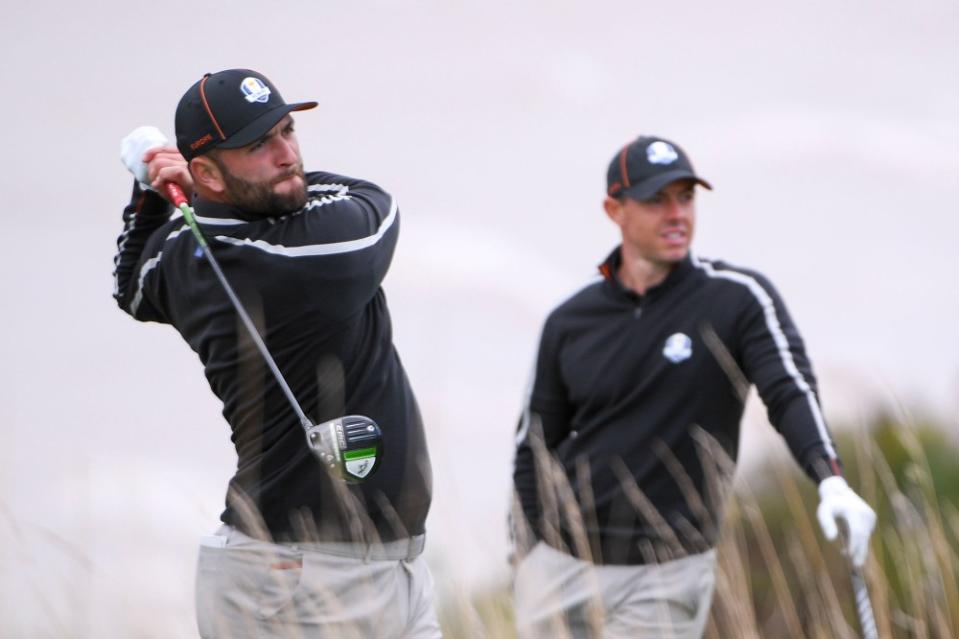Europe captures first Hero Cup, but the real reward is a stronger Ryder Cup side

Golf’s world rankings can often leave folks scratching their heads.
Despite reeling off his third victory in his last five starts with a thrilling win at the Tournament of Champions in Hawaii, Jon Rahm remains anchored to No. 5 on the global order. The anomalies, quirks and curiosities of the official rankings system have irked the Spaniard for a while now.
In his own eyes, however, he knows where he should be on that particular order of merit.
“I feel like since August I’ve been the best player in the world,” he declared with justifiable confidence.
After the first hole of the final round, Rahm trailed runaway leader Collin Morikawa by nine shots. Golf is a strange old business, though. With the kind of rampaging assault that could’ve been accompanied by mounted cavalry, Rahm galloped home with a 10-under 63 while Morikawa, who led the field by six after 54 holes, stumbled over the line with a bogey-riddled finish that was messy.
It was terrific stuff from Rahm. We often say that when Rory McIlroy is in full flight, there’s not a finer spectacle in golf. When Rahm is on a rousing raid, though, it makes for a pretty captivating sight too as he unleashes booming drives, conjures dinky chips and dunts in putts with clinical gusto.
He will, all being well, be a linchpin of the European Ryder Cup team for September’s tussle in Rome. Last weekend in Abu Dhabi, meanwhile, a host of hopefuls got the opportunity to display their Ryder Cup credentials in the new Hero Cup, a team event between Great Britain and Ireland and the Continent of Europe.
It’s basically a rehashing of the old Seve Trophy – not keeping the name “Seve” in it has gone down like a sack of spanners in certain quarters – and it is being viewed as a valuable addition to the Ryder Cup build-up.
Plenty have said it – former European skipper Paul McGinley for one – but the lack of another team contest for potential European Ryder Cup players to be blooded in became a void of growing concern.
When, for instance, the EurAsia Cup – a match in non-Ryder Cup years between European and Asian players – was quietly discontinued back in 2019, another important cog in Europe’s Ryder Cup preparation was lost.
Prior to the EurAsia Cup, the aforementioned Seve Trophy and the Royal Trophy both provided worthwhile platforms but they would eventually wither on the vine. In many ways, these events all served a valuable purpose in terms of a Ryder Cup dress rehearsal and were viewed as part of the successful formula that helped create European cohesion and continuity.
They all offered possible Ryder Cup players a flavor of the team room environment, of playing in the foursomes and fourballs format and generally gelling with their colleagues.
As a breeding ground for prospective European captains, meanwhile, the dry run of a Seve Trophy or a EurAsia Cup was hugely beneficial. McGinley never underestimated its worth.
“I wouldn’t have been [Ryder Cup] captain without the ability to prove myself in the Seve Trophy,” he said of those stints leading GB&I in 2009 and 2011 before his triumphant Ryder Cup captaincy in 2014.
In this year of transition for Europe, Luke Donald, the continent’s Ryder Cup captain, was keen to revive such an outing and the weekend’s affair offered him a fuller picture of the emerging talent at his disposal in a team setting.
Francesco Molinari captained Europe to a 14.5-10.5 win over GB&I in the event’s debut, leading the veteran to add that, “European golf is in very good hands.”
Donald has the strong foundations of his side for Rome – McIlroy, Rahm, Matt Fitzpatrick, et al – but the early opportunity to cast that close eye over the prospects who could also qualify, or nab a couple of his six wildcard picks, certainly provided plenty of material for his burgeoning Ryder Cup files.
List
One year to Italy: What the European 2023 Ryder Cup team could look like


